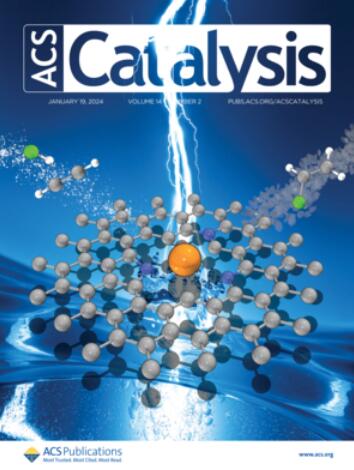From Micro-environments to Macroscopic Effects: How the Alkaline Hydrogen Evolution Reaction Drives Cu Cathodic Corrosion
IF 11.3
1区 化学
Q1 CHEMISTRY, PHYSICAL
引用次数: 0
Abstract
Cathodic corrosion of copper (Cu) has posed a significant challenge for over a century, impeding various technological progresses such as electrochemical conversion of CO2 (eCO2RR) into fuels and other value-added carbon products. In this study, employing a combined density functional theory (DFT) and kinetic Monte Carlo (kMC) simulation approach, we delve into the atomistic-level mechanism driving this phenomenon in Cu. Our hypothesis posits the pivotal role of the alkaline hydrogen evolution reaction (HER) in facilitating cathodic corrosion in Cu. We rigorously develop a pH-dependent hydroxide (OH) adsorption mechanism and calculate the equilibrium OH coverage (θOH) at varying pH levels, the thermodynamic stability of subsurface oxygen (Osub), as well as the Cu-vacancy mediated diffusion of subsurface oxygens (Osub). Through comprehensive analysis, we establish a correlation among various microenvironments, including oxygen diffusion in subsurface layers, pH-dependent OH adsorption, and Cu dissolution into the electrolyte as (Cu–OH) complexes. Furthermore, our investigation explores the correlation between the surface coordination environment of active sites and cathodic corrosion of Cu. Finally, by integrating DFT-derived thermodynamic data into a kMC model, we successfully predict the formation of experimentally observed corrosion pits on Cu surfaces. This combined approach not only advances our fundamental understanding of Cu cathodic corrosion but also offers insights crucial for developing effective corrosion mitigation strategies.

从微观环境到宏观影响:碱性析氢反应如何驱动Cu阴极腐蚀
一个多世纪以来,铜(Cu)的阴极腐蚀一直是一个重大挑战,阻碍了各种技术的进步,例如将二氧化碳(eCO2RR)电化学转化为燃料和其他增值碳产品。在这项研究中,我们采用密度泛函理论(DFT)和动力学蒙特卡罗(kMC)模拟相结合的方法,深入研究了Cu中驱动这种现象的原子水平机制。我们的假设假设了碱性析氢反应(HER)在促进Cu的阴极腐蚀中的关键作用。我们严格建立了pH依赖的氢氧根(OH)吸附机制,并计算了不同pH水平下平衡OH覆盖率(θOH)、亚表面氧(Osub)的热力学稳定性以及cu空位对亚表面氧(Osub)的扩散。通过综合分析,我们建立了各种微环境之间的相关性,包括氧在亚表面层中的扩散,ph依赖的OH吸附以及Cu以(Cu - OH)配合物的形式溶解到电解质中。此外,我们的研究还探讨了活性位点的表面配位环境与Cu的阴极腐蚀之间的关系。最后,通过将dft导出的热力学数据整合到kMC模型中,我们成功地预测了Cu表面上实验观察到的腐蚀坑的形成。这种结合的方法不仅提高了我们对Cu阴极腐蚀的基本理解,而且为开发有效的腐蚀缓解策略提供了至关重要的见解。
本文章由计算机程序翻译,如有差异,请以英文原文为准。
求助全文
约1分钟内获得全文
求助全文
来源期刊

ACS Catalysis
CHEMISTRY, PHYSICAL-
CiteScore
20.80
自引率
6.20%
发文量
1253
审稿时长
1.5 months
期刊介绍:
ACS Catalysis is an esteemed journal that publishes original research in the fields of heterogeneous catalysis, molecular catalysis, and biocatalysis. It offers broad coverage across diverse areas such as life sciences, organometallics and synthesis, photochemistry and electrochemistry, drug discovery and synthesis, materials science, environmental protection, polymer discovery and synthesis, and energy and fuels.
The scope of the journal is to showcase innovative work in various aspects of catalysis. This includes new reactions and novel synthetic approaches utilizing known catalysts, the discovery or modification of new catalysts, elucidation of catalytic mechanisms through cutting-edge investigations, practical enhancements of existing processes, as well as conceptual advances in the field. Contributions to ACS Catalysis can encompass both experimental and theoretical research focused on catalytic molecules, macromolecules, and materials that exhibit catalytic turnover.
 求助内容:
求助内容: 应助结果提醒方式:
应助结果提醒方式:


